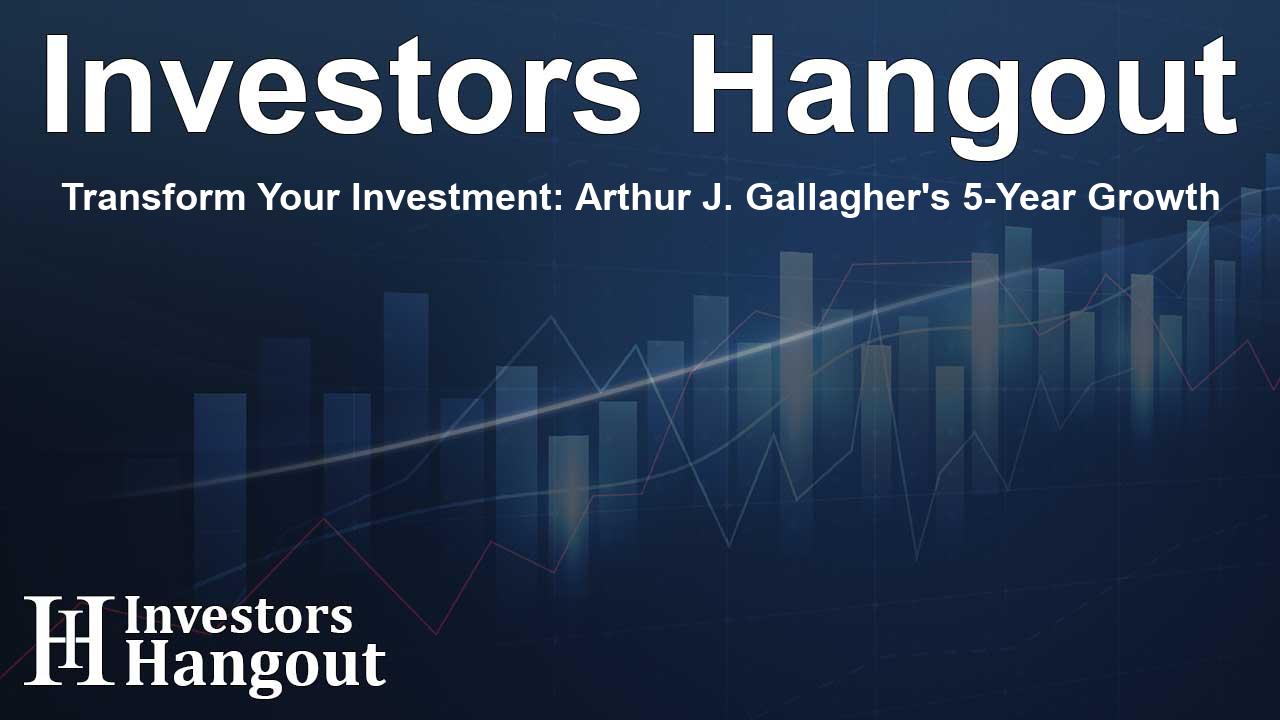Transform Your Investment: Arthur J. Gallagher's 5-Year Growth

Arthur J. Gallagher’s Five-Year Run, In Plain View
Arthur J. Gallagher (NYSE: AJG) has delivered standout results over the past five years. Its annualized return of 27.83% didn’t just keep pace with the market—it beat it by 15.0 percentage points per year. That kind of steady outperformance is rare, and it’s exactly what long-term investors hope to find.
Compounding, Put to Work
Here’s what that looks like in practical terms. If you’d put $100 into AJG five years ago, it would be worth about $343.55 today, based on a current share price of $298.82. The math reflects the quiet force of compounding: gains earn their own gains, and time does the heavy lifting. It doesn’t feel dramatic day to day, but it adds up—then it adds up again.
Where the Company Stands Today
Right now, Arthur J. Gallagher’s market capitalization sits at $65.47 billion. That scale signals staying power and provides the company with flexibility to keep investing in what works.
What’s Behind AJG’s Momentum?
A few steady drivers show up again and again. Arthur J. Gallagher has long leaned on strategic acquisitions to widen its footprint. It’s diversified its services so it isn’t overly dependent on any single line of business. And it’s nurtured strong client relationships by offering comprehensive insurance solutions that meet practical needs. Put together, those choices strengthen its market position and help keep growth on track.
Investing, Without the Jitters
Investing can feel complicated at first. AJG’s story is a reminder that a simple, long-term approach can go a long way. Understand what you own, let compounding work over time, and avoid the temptation to overreact to short-term noise. Past performance isn’t a guarantee, of course, but the principle stands: patience paired with quality can be powerful.
Looking Ahead
No stock moves in a straight line. Market conditions, leadership decisions, and core financial metrics will all shape what happens next. Even so, with Arthur J. Gallagher’s five-year record and its position in the insurance space, the company remains a compelling consideration for investors focused on stability with room to grow.
Frequently Asked Questions
What’s AJG’s average annual return over the last five years?
Arthur J. Gallagher’s average annual return over the past five years is 27.83%.
If I invested $100 in AJG five years ago, what would it be worth today?
About $343.55, based on the current share price of $298.82.
What’s driving Arthur J. Gallagher’s performance?
Consistent strategic acquisitions, a diversified service mix, and strong client relationships—supported by comprehensive insurance solutions.
What’s AJG’s current market capitalization?
Arthur J. Gallagher’s market cap is $65.47 billion.
Is AJG a good investment?
It may be, depending on your goals and risk tolerance. Given its track record and standing in the insurance sector, many investors view AJG as a candidate for long-term stability and growth.
About The Author
Contact Olivia Taylor privately here. Or send an email with ATTN: Olivia Taylor as the subject to contact@investorshangout.com.
About Investors Hangout
Investors Hangout is a leading online stock forum for financial discussion and learning, offering a wide range of free tools and resources. It draws in traders of all levels, who exchange market knowledge, investigate trading tactics, and keep an eye on industry developments in real time. Featuring financial articles, stock message boards, quotes, charts, company profiles, and live news updates. Through cooperative learning and a wealth of informational resources, it helps users from novices creating their first portfolios to experts honing their techniques. Join Investors Hangout today: https://investorshangout.com/
The content of this article is based on factual, publicly available information and does not represent legal, financial, or investment advice. Investors Hangout does not offer financial advice, and the author is not a licensed financial advisor. Consult a qualified advisor before making any financial or investment decisions based on this article. This article should not be considered advice to purchase, sell, or hold any securities or other investments. If any of the material provided here is inaccurate, please contact us for corrections.
